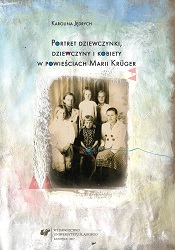Portret dziewczynki, dziewczyny i kobiety w powieściach Marii Krüger
Image of a Little Girl, an Adolescent and a Woman in the Novels of Maria Krüger
Author(s): Karolina Jędrych
Subject(s): Literary Texts, Studies of Literature, Polish Literature, Philology
Published by: Wydawnictwo Uniwersytetu Śląskiego
Keywords: novels for children and teenagers; novels for teenage girls; Maria Krüger; gender; phantasm; Bachelard
Summary/Abstract: The subject of my analyses and interpretations is eight novels by Maria Krüger (1904–1999) - Polish journalist, editor and, after World War II, author of books mainly for children and teenagers. The novels I interpret include a novel for children aged 8 to 12 (Klimek i Klementynka, 1962), novels for teenage girls (Szkoła narzeczonych, 1945; Petra, 1957; Godzina pąsowej róży, 1960; Po prostu Lucynka P., 1980; Odpowiednia dziewczyna, 1988) and women (Brygida, 1970; Gorzkie wino, 1975). Krüger’s best known novels are Karolcia and Godzina pąsowej róży. Many studies concerning Polish novels for children and teenagers point to the innovative nature of Krüger’s writing, however, no study of her literary output or her biography have been written thus far. My dissertation is the first attempt to interpret her novels. I have based it on the literary output of feminist criticism and gender studies, mainly the texts of Lissa Paul concerning three strategies of gender reading of literature for young readers: rereading, reclaiming, redirection.My book has been divided into two parts. The first one – entitled Image background. Girlhood novel as a safe place. – deals with what the heroines of Krüger’s books say and think about the genre called “novels for girls”, especially the type called “boarding school novels”. It turns out that the life portrayed in such novels is a dream of one of the heroines, and other ones perceive the world presented in the boarding school novel as safe, as topophilia written about by Gaston Bachelard and – in relation to novels for young readers – by Alicja Baluch. The world of these novels can be perceived in such a way due to the fact that in the real world, when Krüger was writing Szkoła narzeczonych and Petra, it was the time of World War II. Krüger spent that time in occupied Warsaw. Many characters in her books mention the war, the occupation and the Warsaw Uprising, and talk about the cruelty of the world and their wish for peace and happiness after the war.In part one, I also mention the references to films in Krüger’s novels, the filming of Godzina pąsowej róży and the differences between the world portrayed in this novel and in Gorzkie wino – a book for women, the action of which takes place around the same time as in the case of Godzina...The second part of my book has been divided into three chapters – portrayals of heroines. In the first chapter – Dressed – I discuss the function of clothes in Krüger’s novels. Clothes are, among others, a way to express subjectivity and construct identity – also the sexuality (two female heroines dress as boys to do forbidden things) – to take control over another person, but they are also a source of pleasure (buying clothes is entertaining).Another portrayal – Appropriate – is an attempt to retrace the characteristics of heroines which allow them to be perceived as girls appropriate for men they marry or will marry in the future. I look at the model of femininity that the author sets in her novels. On the one hand, it is an exemplary housewife, and on the other hand – a girl, an independent woman, an artist.The final chapter of part two is entitled Mother. It discusses the relations of heroines with their mothers and (despite the title) fathers. I focus on the two novels for women – Gorzkie wino and Brygida. Their protagonists – Adelajda and Brygida – were brought up by domineering mothers. The fate of these heroines confirms the thesis that the relations with parents, especially mothers, greatly influence one’s life. In conclusion I write about autobiographic motives in Krüger’s novels for children, teenagers and adults. However, due to the lack of sources that could confirm my presumptions and conclusions, this part is, unfortunately, not very long and exhaustive.
Series: Studia literackie
- E-ISBN-13: 978-83-226-3042-6
- Print-ISBN-13: 978-83-226-3041-9
- Page Count: 200
- Publication Year: 2017
- Language: Polish
- eBook-PDF
- Table of Content
- Introduction

